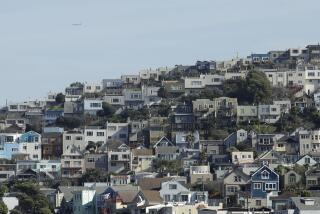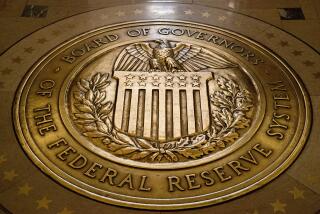Mortgage rates defied forecasts in 2014; what’s ahead in 2015?
Housing economists were nearly unanimous a year ago: U.S. mortgage rates would rise in 2014 because the Federal Reserve was unwinding a key economic stimulus that had helped keep long-term interest rates low.
But as the year passed, the Fed’s pull-back was overshadowed by dormant inflation at home and slowing economies and rising political tensions elsewhere in the world. Global appetite for safe U.S. Treasury securities and government-backed mortgage bonds — as well as sluggish demand for home loans — pushed rates lower.
So instead of the year ending with 30-year mortgage rates at 5%, as many had projected, it wound up at an average of 3.87%, according to housing finance giant Freddie Mac.
Estimates for where rates go this year seem less certain.
Many prominent industry leaders, including those at the Mortgage Bankers Assn., once again expect them to end at about 5%. The trade group has pegged it at 5.1%.
But for many others, their forecasts now come with more sheepish comments about clouded crystal balls. Some observers think rates could stay low or even decline.
“I’ve been wrong about fixed mortgage rates all year. Instead of rates rising, they fell,” acknowledged Mark Zandi, the chief economist for Moody’s Analytics. He said he wouldn’t be surprised if fixed mortgage rates are near 4.5% at the end of 2015.
Pressure on borrowing rates started more than six years ago, during the Great Recession.
The Fed took two unprecedented steps — buying Treasury and higher-quality mortgage-backed bonds each month and lowering its benchmark interest rates to or near zero. Both were designed, in part, to push down long-term interest rates, spur borrowing and, thus, stimulate the economy.
Last year’s unwinding of the bond-buying effort, which the central bank voted on in late 2013, prompted the mortgage bankers group, for one, to estimate that the 30-year rate would hit 5% in the third quarter of 2014 and end the year at 5.1%.
For this year, the mortgage bankers group said it expects rates to rise because, as many anticipate, the Fed is likely to push up its short-term interest rates by mid-2015.
“We expect that as the U.S. economy continues to grow, the Federal Reserve will raise short-term rates, and longer-term rates, including mortgage rates, will increase as a result,” said Michael Fratantoni, the lobbying group’s chief economist.
The wild card, though, is reaction to global issues, which sent cash flooding into the United States this year. Heavy demand for safe investments pushed down yields on Treasury securities and mortgage bonds backed by Fannie Mae, Freddie Mac, the Federal Housing Administration and the Veterans Administration.
“We continue to see a strong preference for safer U.S. assets,” Fratantoni said.
When the interest paid on mortgage bonds declines, the interest rates paid by borrowers generally follow. That trend helped to offset the wind-down of the Fed’s massive monthly purchases of bonds.
Frank Nothaft, chief economist for Freddie Mac, said rates also were held down early last year by an unforeseen first-quarter contraction in the gross domestic product, the nation’s total economic output, from the effects of the long, frigid winter.
The prospect of higher rates this year has many lenders urging would-be home buyers to act soon.
“Interest rates on mortgages are extremely low,” said Donald Frommeyer, chief executive at the Assn. of Mortgage Professionals, which represents brokers and bankers. “And they will go up, probably within the next several months.
“Plus, there are measurable tax benefits for homeowners,” he said. “So if you think homeownership could be right for you, now is the time to get your ducks in a row.”
------------
FOR THE RECORD
Jan. 2, 1:20 p.m.: An earlier version of this article incorrectly identified Assn. of Mortgage Professionals Chief Executive Donald Frommeyer as Eric Frommeyer.
------------
There’s no arguing the effects of higher mortgage interest rates. A homeowner with a 30-year mortgage of $417,000 — the highest allowed in most of the country for loans backed by Fannie and Freddie — would face monthly payments of $1,960 at 3.87% annual interest. That would rise to $2,239 were the rate 5%.
In many higher-cost areas, including Los Angeles and Orange counties, the limit for Fannie and Freddie loans is $625,500. The payment on a mortgage of that size, $2,940 a month at 3.87%, jumps to $3,358 at 5% annual interest.
At Mortgage Grader brokerage in Laguna Niguel, the expectation for 30-year fixed rates is “at or under 4% all year,” said owner Jeff Lazerson.
“They may even dip to 3%,” Lazerson said. “With low gas prices leading the way, we have no inflationary pressures.”
And with “the warring, geopolitical unrest and slow economies in Europe and Asia, there will be an ongoing flight to safety, meaning the U.S. Treasury market is the most attractive place to park your money,” he said. “That’s a guarantee to keep rates down.”
Longtime financial analyst Richard Bove of Rafferty Capital Markets said the ultra-low rates would remain because recent global developments amount to “black swan events” — out-of-the-blue occurrences with major, unforeseen effects.
The European Central Bank has imposed negative interest rates, charging to accept deposits, to discourage banks from hoarding funds, which, in turn, “depresses rates everywhere,” Bove said.
Recent Bank of Japan stimulus programs amount to “printing money like crazy,” all of which, coupled with the rising strength of the dollar, result in “money pouring in to us,” he said.
“These are events the Fed did not consider and can’t handle,” Bove said. “If every other bank in the world wants to push rates down and the Fed wants to push them up, I don’t see how they’re going to do it.”
Twitter: @ScottReckard







